When a Project Manager is presented with a project and asked, “Can you do this?”, “How long will it take?”, “How many resources will you require?” his immediate answers can only include that to question one, going like: “I think so.” To answer the other two questions, he will need time.
What is time estimation in project management?
Time estimation in project management is the process of predicting the amount of time required to complete specific tasks or an entire project. It involves analyzing the project scope, breaking down work into smaller tasks, and determining how long each task will take to complete. Time estimation in project management is a critical step in planning, as accurate time estimates help set realistic deadlines, allocate resources effectively, and ensure project deliverables are met within the given timeframe.
Now, to calculate time estimation in project management, we need a detailed plan involving all the tasks, estimates, required budget, and team members, taking into account their skills, expertise, and so on. To simplify this formula, we can combine most of the criteria and get this:
- Number of tasks needed to complete
- The duration of those tasks
- The number of team members working on those tasks
What‘s good about this formula from a project manager‘s perspective is that all three questions can be effectively answered if the exact number of tasks is known. In other words, if you‘re experienced and know your team well, you can pretty easily tell how much time each task will take to complete and how many team members you need to work on those.
5 time estimation methods in project management
Top-down and bottom-up methods
One of the best practices to improve time estimation accuracy in project management is to utilize historical data. By reviewing past projects that are similar in scope, you can make more informed assumptions about how long tasks might take and the resources required. Many project management software platforms offer tools to capture and analyze such data, which can be valuable when creating these estimates.
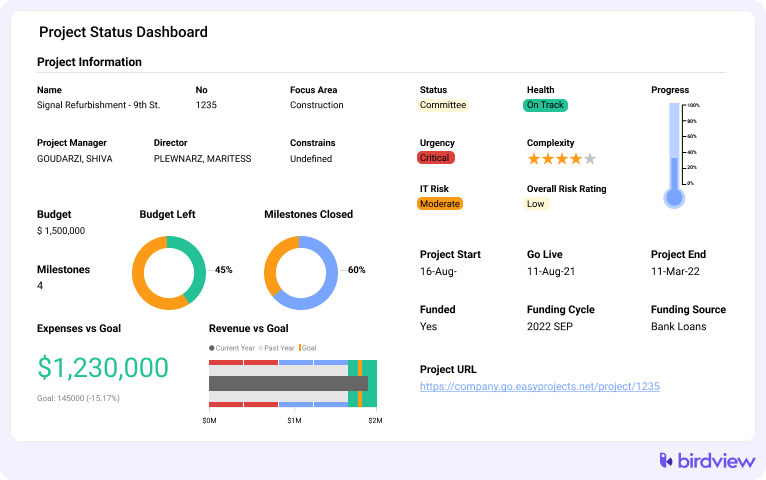
This is where Top-Down and Bottom-Up approaches step in. While the calculations can be made using either of the two, there are a number of differences between them and each should be used in a corresponding scenario for maximum effect.
For those who don‘t know:
“Top-Down approach focuses on the main project deliverable and breaks it down into smaller chunks of work needed to be done, until, finally, all the to-do tasks are clear.” – This is usually performed by the PM and the details of the small tasks get cleaned up by the team.
“The Bottom-Up approach focuses on the team members resolving all the phases and tasks of the project to form the end deliverable” – This is performed by the whole team right off the bat (under the supervision of the PM) and all the small details are taken care off from the start.
Top-down method for time estimation in project management
The Top-Down method is a time estimation approach in project management that begins with a high-level view of the project. This method allows project managers to quickly create a general framework by breaking down the final deliverable into manageable tasks. It is especially useful when time is a pressing factor and there is enough past data to guide the estimations. However, while it offers speed and efficiency, it may lack precision when it comes to accounting for detailed, task-specific challenges.
When to use it: Great for high-level planning or when you‘re in the early stages of a project and don‘t have all the details yet.
Pros: It‘s quick and easy. Perfect for setting expectations upfront.
Cons: It can be overly optimistic or generic, leaving gaps once you dive into the details.
The top-down method of time estimation in project management is ideal for:
- Experienced project managers or teams familiar with similar projects.
- Projects with tight deadlines.
- Situations where quick, high-level estimates are needed.
- Well-defined projects with clear goals and historical data.
- Projects that have been done before, allowing experience to guide estimations.
Advantages
The Top-Down approach works well if the project is clearly defined, has a clear end goal and there are previous examples of such projects that a PM can use as a guideline. All this information allows a PM to quickly define the major tasks and break those down into smaller chunks of daily tasks.
This approach is suited for cases when you don‘t have a lot of time to answer the ultimate question “how long will it take?”, and at the same time, have a lot of data to work with.
Disadvantages
Though the Top-Down approach can be useful in terms of quick (and pretty realistic) time and budget estimation in project management, there will most certainly be problems that will come up somewhere in the process of doing all the tasks. The thing is that it‘s impossible for a PM to singlehandedly think about all the details since obviously, no PM is equally strong in all aspects of a given project.
Here is an example:
Suppose you have a project to upgrade your product‘s hardware and software layers. Since this kind of stuff has been done in the past, you know you‘ll need:
- A bunch of new servers
- Create the updated operating system
- Install the new system on those servers
- Install the latest product version
Since you know all the major components, it will be quite easy to break those down into smaller, day-to-day tasks and assign those to team members. What you might not know though, is that the new operating system doesn‘t work with your product because of API integration problems, or library issues, or it might mess up user information security and whatnot.
These problems will most probably be discovered in the process by team members and, depending on their size, mess up both your time and cost calculations. In the end, you will have to take more time to complete the project than you previously estimated, and more resources as well.
One could argue that it‘s not the PM‘s fault and this is a pretty common thing in the project management world, but hey, I doubt anybody‘s going to listen.
“You said August 2016. It‘s already September and the project is not even close to done yet.” – This is what you will get most of the time.
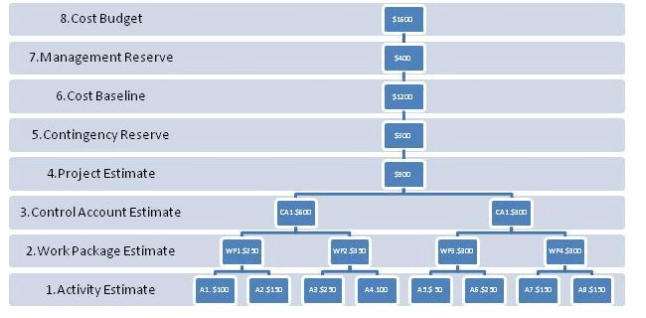
Bottom-up method for time estimation in project management
The Bottom-Up method for time estimation focuses on developing a more granular understanding of a project by building the plan from the ground up. It involves the team members who will execute the tasks, ensuring that all necessary details are considered early in the planning process. While this approach is more time-consuming, it provides a higher level of accuracy by addressing potential challenges before they arise.
When to use it: Perfect for complex projects with clearly defined deliverables or when accuracy is non-negotiable.
Pros: It‘s thorough and reliable. You won‘t miss hidden tasks that could derail your project later.
Cons: It can be time-consuming, especially if you‘re managing a large project.
The bottom-down method of time estimation in project management is ideal for:
- Teams working on complex or unfamiliar projects.
- Organizations that prioritize accuracy over speed in the planning process.
- Projects requiring detailed, task-specific estimations.
- Situations where thorough planning is crucial to avoid future risks and challenges.
Advantages
Unlike the Top-Down approach, Bottom-Up will involve the whole team in the process of defining the tasks needed to complete a project, allowing them to consider all the details that a PM might not know about, and come up with a much more specific figure.
Using the example above, the whole team would brainstorm about it, and the guys responsible for quality assurance and security would probably think about the potential issues (or at least make a task to test), thus helping their PM out and making sure there will be no unexpected stuff coming up out of nowhere.
Disadvantages
On the downside, this method of time estimation in project management will require significantly more time to answer the ultimate question, “How long will it take?” and, since all the team members are actively involved in the brainstorming process, it offers less control over the project.
This approach should be used when you are on no tight deadlines (or at least have enough time to carefully plan and analyze everything), and will also help encourage teamwork within the organization by allowing much more freedom to team members. It‘s also a good approach if you, as the PM, don‘t have any past, similar projects to use as a guide and are completely new to the sphere.
In practice, project management tools can help streamline the Bottom-Up approach by facilitating collaboration. For example, team members can input their individual task estimates and dependencies directly into the software, allowing for real-time updates and adjustments as new information comes to light. This can drastically improve the overall accuracy of the final project timeline.
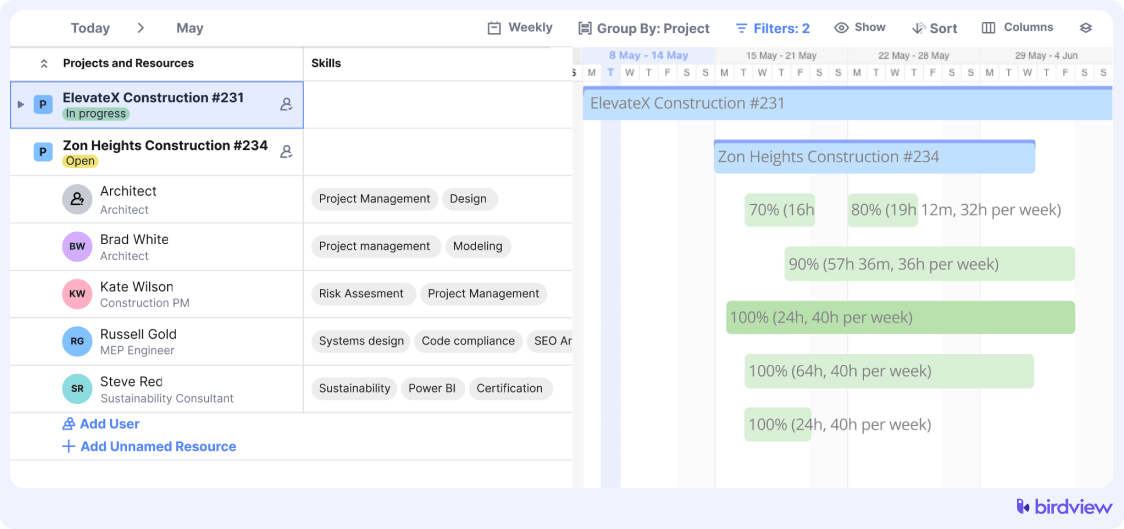
Once you have the number of tasks, depending on the method you choose to go with, you can now decide how much time, resources, and budget they will require to be completed.
Again, with Top-Down, you will be able to get the answers quickly, but there will be some inevitable estimation errors since the details of the tasks are yet to be figured out. With Bottom-Up, you will be able to come up with the most accurate answer but require significantly more time to do so.
Critical path method (CPM)
If you are feeling overwhelmed by all the moving parts of your project, CPM can help you focus on the tasks that matter most. This method identifies the longest sequence of dependent tasks (the “critical path”) and calculates the time needed to complete them.
When to use it: Ideal for complex projects with many interdependencies.
Pros: Highlights bottlenecks and helps prioritize.
Cons: Can overlook smaller tasks that aren‘t on the critical path.
Analogous estimation
Let‘s say you‘ve worked on similar projects before. Why reinvent the wheel? With analogous estimation, you use past projects as a benchmark for predicting timelines. Compare your current project to one with similar tasks, scope, or complexity. If that one took eight weeks, chances are this one will too–give or take. The key here is to account for differences between projects. Otherwise, you might end up with a timeline that‘s more hopeful than realistic.
When to use it: Ideal for projects that have a lot in common with previous ones.
Pros: Fast and straightforward, especially when you‘re working under tight deadlines.
Cons: It assumes history will repeat itself, which isn‘t always the case.
Parametric estimation
Numbers don‘t lie–at least, not when used correctly. Parametric estimation relies on measurable data to predict time. For example, if you know it takes a team five hours to design one webpage, you can estimate 50 hours for a project requiring 10 pages.
When to use it: Great for tasks with repeatable, measurable components.
Pros: It‘s precise and scalable.
Cons: Relies on having accurate, detailed historical data, which isn‘t always available.
How to choose the right time estimation approach
🎯 Balance accuracy with organizational needs
Of course, stakeholders, PMs, and investors all want to have accurate cost and time figures, but the level of accuracy must be balanced with the other needs of the organization. Prioritizing your priorities will come in handy here as well.
- If time is of the essence, Top-Down might be the best way to approach a project.
- When precise figures are more important, Bottom-Up could be the way to go.
🔀 Combine methods for flexibility
Since we live in the real world (sadly), I am pretty positive that most of the time, neither of the above-mentioned works on their own, so using a mix of both methods might be a good solution.
Start by identifying the aspects of the project:
- Where speed is critical → assign top-down methods to high-level, predictable phases.
- Where accuracy is essential → delegate bottom-up analysis to areas requiring greater detail or those with higher uncertainty.
🔍 Involve your team in brainstorming
For example, you could break down the project into a few phases:
- Implement Top-Down for the phases you know everything about
- Ask your team to brainstorm on the ones you feel uncomfortable with
When asking your team to brainstorm, provide them with context and specific questions to answer. For instance, ask them to assess task dependencies or estimate how long each component might take based on their expertise. Tools like whiteboards or collaboration platforms can help structure these discussions effectively.
🛠️ Leverage project management tools
A hybrid approach that combines both Top-Down and Bottom-Up can be further optimized by using project management software that supports phased project execution. Leverage features like Gantt charts, task dependencies, and resource allocation tools to visually track each phase and identify areas where adjustments are needed.
👥 Maintain project control
Regularly revisit the estimates at the end of each phase to align with real-time progress and eliminate guesswork for the next phase. By breaking the project into phases, you can adjust and refine estimates after completing each phase, improving the accuracy of your resource allocation as you progress.
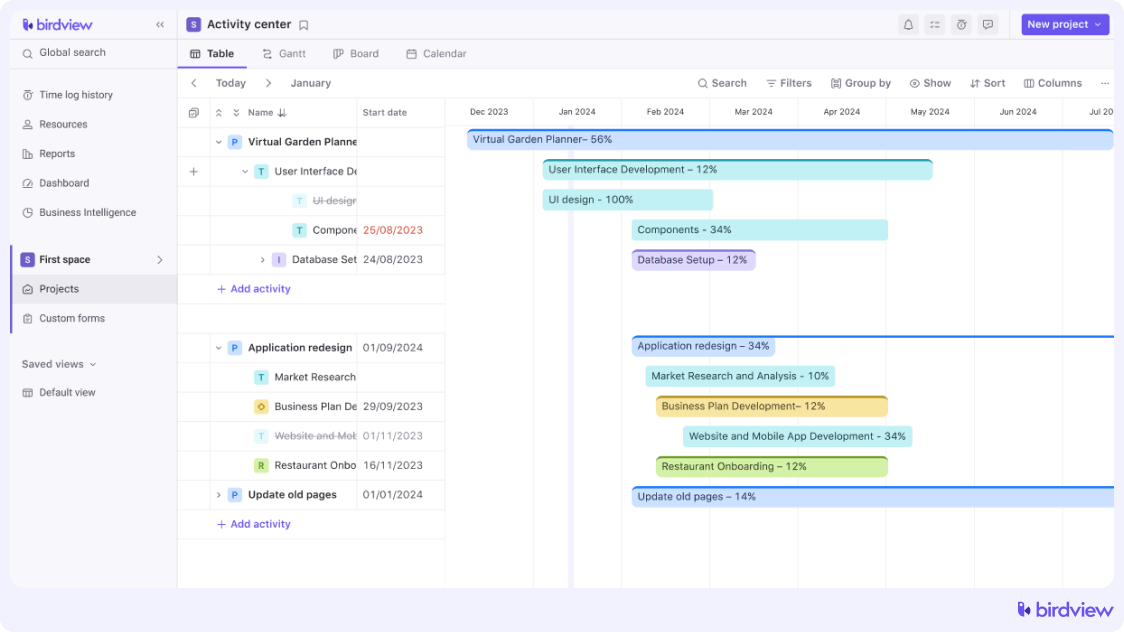
Plus, this way, maintaining project control will be a lot easier than if you simply throw everything into your team‘s hands. Don‘t get me wrong: I‘m sure all of them will try their hardest to come up with the best solution, but when too many people are working on the same task without any control, things are bound to go out of hand sooner or later. To avoid this, designate clear roles and responsibilities for each phase and task. Ensure that every team member knows what they are accountable for, and schedule regular check-ins to monitor progress and offer support where needed. This ensures alignment and keeps the project on track.
Tips for effective time estimation in project management
Accurate time estimation in project management can be challenging, but using proven strategies can significantly improve the process. Here are some tips to help project managers and teams create more reliable time estimates:
1. Divide the project into smaller, manageable tasks.
Why it helps: Large tasks are harder to estimate accurately because they involve multiple unknowns. Breaking them into smaller, well-defined units makes time estimation more manageable.
💡 Tip: Use the Work Breakdown Structure (WBS) to divide the project into individual tasks or deliverables. Estimate time for each piece before rolling them up into the overall timeline.
2. Use data from similar past projects to inform your estimates. Adjust for any differences in project scope or complexity.
Why it helps: Past projects can provide valuable insights into how long similar tasks or projects have taken.
💡 Tip: Use BI reports and dashboards to access and analyze historical project data. These tools can highlight average task durations, resource utilization trends, and areas where delays occurred. By turning raw data into actionable insights, you can base your time estimates on facts, not guesswork.
3. Get input from team members who will complete the tasks. Their expertise ensures more accurate and realistic estimates.
Why it helps: The people doing the work often have the best insight into how long tasks will actually take. Their involvement not only improves the accuracy of your estimates but also boosts buy-in and accountability.
💡 Tip: Use collaboration tools to gather input efficiently. Enable team members to share their insights, discuss potential roadblocks, and refine estimates in real time.
4. Include a time buffer for unexpected challenges like technical issues or resource shortages to prevent delays.
Why it helps: Unexpected delays are inevitable–team members fall sick, priorities shift, or unforeseen technical challenges arise.
Tip: Build contingency time for critical tasks. A common practice is adding 10-20% to your initial estimates as a safety buffer.
5. Ensure time estimates reflect actual team capacity, avoiding overloading team members and risking delays.
Why it helps: Team members don‘t work at full capacity all the time. Holidays, meetings, and personal commitments can eat into productive hours.
💡 Tip: Use realistic assumptions about availability. If a task takes 20 hours of work, but your team member is only available for 4 hours per day, allocate 5 working days for completion.
6. Revisit your estimates as the project progresses. Adjust based on new information or changes in scope.
Why it helps: Projects evolve, and new information becomes available, making initial estimates less accurate over time.
💡 Tip: Schedule regular checkpoints to update estimates as the project progresses. Use tools like agile sprints or milestones to refine timelines iteratively.
How to use Birdview for time estimation
Birdview offers a range of tools to simplify and improve time estimation in project management. Here’s how to use it effectively:
- Create a work breakdown structure (WBS)
Start by breaking your project into smaller tasks using Birdview’s WBS feature. This helps you organize the project into manageable components, making time estimation easier.
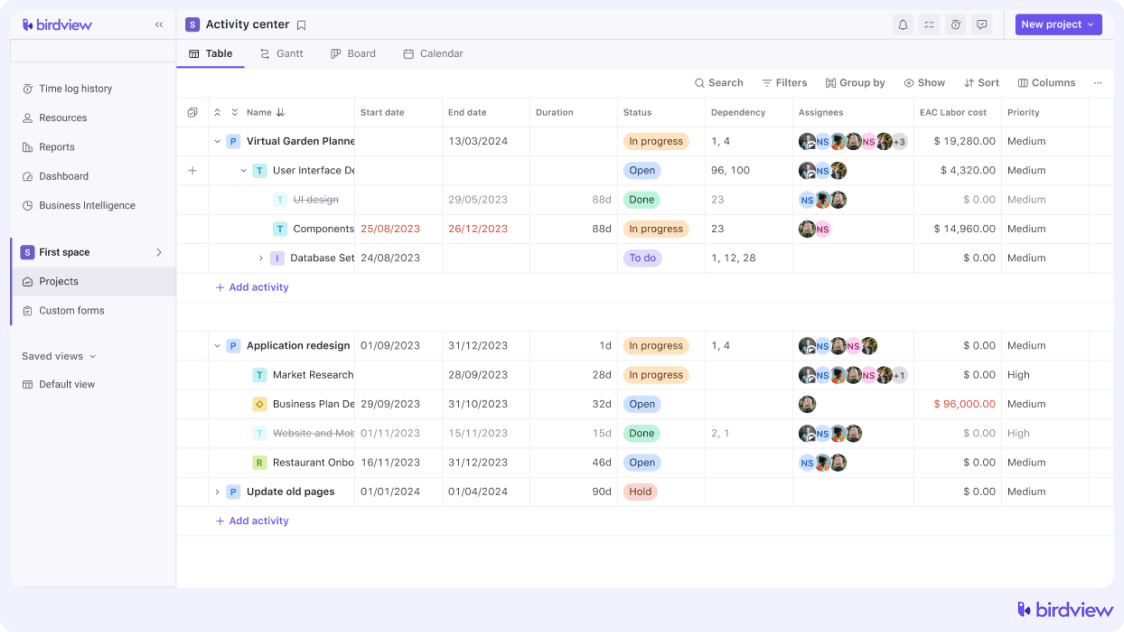
- Assign resources and time estimates
For each task, assign the appropriate team members and input estimated time durations. Birdview allows you to track each team member’s availability and workload to ensure realistic scheduling. - Use task dependencies
Set up task dependencies to define the order of completion. Birdview automatically adjusts timelines based on dependencies, helping to create a more accurate project schedule. - Monitor progress with real-time updates
As your project progresses, Birdview tracks actual time spent on tasks, allowing you to compare estimates with real-time data. This helps refine future estimates and keeps your project on track.
Related time estimation and management content
To further enhance your project management skills and improve your ability to estimate time accurately, explore these related articles and resources. These insights will help you refine your approach and ensure your projects stay on track.
What are your thoughts on those two approaches to project management? Tell us about your experience and how you handle different projects, we are dying to know!



